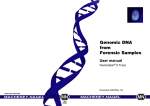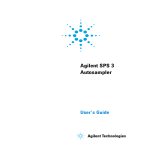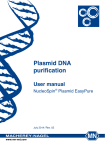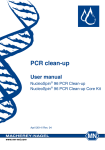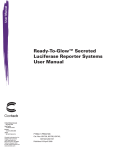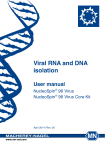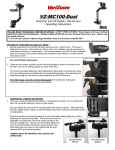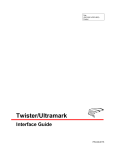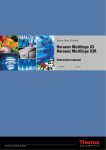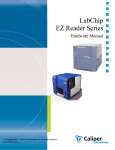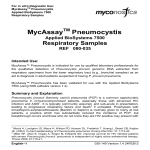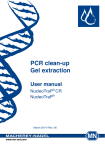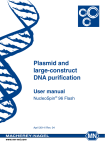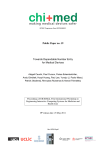Download - Bioke.com
Transcript
Automated Plasmid DNA Purification User manual NucleoSpin® Robot-96 Plasmid Core kit August 2002/Rev. 01 www.mn-net.com MACHEREY-NAGEL MN TÜV CERT DIN EN ISO 9001.2000 Certificate: 01 100 5507 MACHEREY-NAGEL MN Automated Plasmid DNA Purification Table of contents 1 Kit contents 4 2 Product description 5 2.1 The basic principle 5 2.2 Kit specifications 5 2.3 Elution procedure 6 2.4 Automation 8 3 Storage conditions and preparation of working solutions 4 Growing of bacterial cultures 9 10 4.1 Selection of culture medium 10 4.2 Cultivation of bacteria in a square-well block 10 4.3 Cultivation of bacteria in tubes 10 5 General Procedure 12 5.1 Standard protocol for automated purification of high-copy plasmid DNA using common laboratory automation workstations 15 5.2 Support protocol - Elution of DNA using a centrifuge 6 Appendix 17 18 6.1 Troubleshooting 18 6.2 Ordering information 21 6.3 References 21 6.4 Product Use Restriction / Warranty 22 MACHEREY-NAGEL – 08/2002/ Rev. 01 3 Automated Plasmid DNA Purification 1 Kit contents NucleoSpin® Robot-96 Plasmid Core Kit 24 x 96 preps1 Cat.No. 740 616.24 Buffer A1 6 x 200 ml Buffer A2 6 x 200 ml Buffer A3 6 x 200 ml Buffer A4 (concentrate)2 6 x (4 x 100 ml) Buffer AE 6 x (2 x 50 ml) RNase A2 6 x 80 mg NucleoSpin® Plasmid Binding Plate (transparent) 24 NucleoSpin® Plasmid Filter Plate (purple) 24 MN Wash plate (including six paper sheets) 24 Protocol 1 2 6x1 The NucleoSpin® Robot-96 Plasmid Core Kit consists of 6 boxes with 4 x 96 preps each. For preparation of working solutions and storage conditions see section 3. 4 MACHEREY-NAGEL – 08/2002/ Rev. 01 Automated Plasmid DNA Purification 2 Product description 2.1 The basic principle The NucleoSpin® Robot-96 Plasmid procedure is a modified version of the Birnboim and Doly alkaline lysis plasmid miniprep protocol. Bacterial cultures are harvested by an initial centrifugation step. After resuspension of the pelleted bacteria (buffer A1) and alkaline cell lysis (buffer A2), a neutralization and binding buffer (buffer A3) containing large amounts of chaotropic ions is added. Resulting bacterial crude lysates are cleared by vacuum filtration with the NucleoSpin® Plasmid Filter Plate. The cleared lysates containing the plasmid DNA are collected into the NucleoSpin® Plasmid Binding Plate. The chaotropic salt leads to a reversible adsorption of the plasmid DNA to the NucleoSpin® silica membrane during the second vacuum-filtration step. High purity of the final plasmid DNA preparation is achieved by complete removal of cellular contaminants, salts, detergents, and other compounds in subsequent washing steps. Highly pure plasmid DNA is finally eluted with elution buffer AE (5 mM Tris/HCl, pH 8.5) or water (pH 8.0-8.5), and can be directly used for further applications. 2.2 Kit specifications • NucleoSpin® Robot-96 Plasmid is designed for the automated 96-well smallscale purification of high-copy plasmid DNA from E. coli in the microtiter plate format. • The kit is for use with common laboratory automation workstations (see section 2.3). • This kit provides reagents and basic consumables (NucleoSpin® Filter Plate, NucleoSpin® Plasmid Binding Plate, MN Wash Plate) for purification of up to 15-20 µg of highly pure plasmid DNA suitable for direct use in standard molecular biology applications like automated fluorescent sequencing, PCR, or restriction analysis. • Using the NucleoSpin® Robot-96 Plasmid kit allows simultaneous processing of up to 96 samples typically within less than 90 minutes. Actual processing time depends on configuration of workstation used. • Typically yields of 5-15 µg plasmid DNA can be purified from 1.5 ml overnight cultures. • Yield depends on copy number and size of plasmid (<15 kbp), selected culture medium, and bacterial host strain. • Membrane capacity is about 20 µg. The final concentration of eluted DNA is 50-200 ng/µl (depending on elution buffer volume and bacterial culture). MACHEREY-NAGEL – 08/2002/ Rev. 01 5 Automated Plasmid DNA Purification • Typically, the A260/280 ratio is > 1.8. Eluted DNA is ready-to-use for e.g. automated fluorescent sequencing (e.g. ABI 3700, 3100, 377, 373, LICOR, MegaBace, ALF), restriction analysis, and PCR. Kit specifications at a glance NucleoSpin® Robot-96 Plasmid Culture volume 1.5 ml Average yield 5-15 µg Elution volume 75-150 µl Binding capacity 20 µg Vectors < 15 kb 90 min/96 preps Time/prep 2.3 Elution procedure See table for correlation between dispensed elution buffer volume and typical recoveries following the standard protocol. The default volume of dispensed elution buffer in the available programs is 125 µl. Dispensed elution buffer 75 µl 100 µl 125 µl Recovered elution buffer containing plasmid DNA 30±5µl 55±5 µl 80±5 µl 6 MACHEREY-NAGEL – 08/2002/ Rev. 01 150 µl 175 µl 105±5 µl 130±5 µl Automated Plasmid DNA Purification 250 100 recovery [µg] 150 80 recovery [%] 9 60 8 40 7 100 recovery, % 200 DNA recovered, µg concentration, ng/µl 10 20 6 concentration 50 5 0 60 80 100 120 140 160 180 200 140 160 dispensed elution buffer, µl 20 40 60 80 100 120 recovered elution buffer, µl Fig. 1: Recovery rate and concentration depend on elution volume. 10 µg of pBluescript were purified with NucleoSpin® Robot-96 Plasmid and eluted with the indicated elution buffer volumes. High recovery is achieved with 120 µl elution buffer (dispensed), as concentration drops. A B C Fig. 2: Purity and yields of pBluescript KS+ (2.96 kbp, A), pUC 18 derivate (3.65 kbp, B), pcDNA3.1 (8.6 kbp, C), and pCMVβ (7.2 kbp, D) using NucleoSpin® Robot-96 Plasmid. 15 µl out of 125 µl eluate were analyzed on a 1% agarose gel. D MACHEREY-NAGEL – 08/2002/ Rev. 01 7 Automated Plasmid DNA Purification 2.4 Automation NucleoSpin® Robot-96 Plasmid is designed for use on common laboratory automation workstations, such as: Robot Supplier Robot Beckman-Coulter Biomek 2000/FX Cavro MiniPrep series Hamilton Microlab STAR MWG RoboSmart/RoboPrep Perkin Elmer MultiPROBE II/II HT Qiagen BioRobot 9600/3000/8000 Tecan Genesis RSP/RWS Separation System series Zymark SciClone ALH Note: As other laboratory automation workstations are currently under evaluation please contact MN directly if your workstation is not on this list. Visit MN on the internet at www.mn-net.com or contact your local MACHEREYNAGEL distributor for availability of ready-to-run scripts and for technical support regarding hardware, software, setup instructions, and selection of the protocol. All MN protocols can be downloaded from our website. 8 MACHEREY-NAGEL – 08/2002/ Rev. 01 Automated Plasmid DNA Purification 3 Storage conditions and preparation of working solutions Attention: Buffer A3 contains guanidinium hydrochloride which is an irritant! Buffer A2 contains SDS and sodium hydroxide which are irritant and hazardous. Wear gloves and goggles when handling them! • Before first use of the kit, add 1 ml of buffer A1 to the RNase A vial and vortex. Transfer the whole amount of redissolved RNase A to the buffer A1 bottle and mix thoroughly. Store buffer A1 containing RNase A at 4°C (buffer A1 including RNase A is stable for up to 6 months). Equilibrate buffer A1 to room temperature before starting plasmid DNA preparation. • All other components of the NucleoSpin® Robot-96 Plasmid kit should be stored at room temperature (for a maximum of one year). Storage of buffer A2 at temperatures below 20°C may cause precipitation of SDS. If a salt precipitate is observed, incubate the bottle at 30-40°C for some minutes, and mix well until all of the precipitation is redissolved. • Add indicated volume of 96% ethanol to buffer A4 concentrate before use. NucleoSpin® Robot-96 Plasmid Core kit 24 x 96 preps Cat. No. 740616.24 Buffer A4 (concentrate) 24 x 100 ml add 400 ml ethanol to each bottle MACHEREY-NAGEL – 08/2002/ Rev. 01 9 Automated Plasmid DNA Purification 4 Growing of bacterial cultures 4.1 Selection of culture medium The cultivation of cells is recommended at 37°C in LB (Luria-Bertani) medium at constant shaking (200-250 rpm). Alternatively, rich media like 2 x YT or TB (Terrific Broth) can be used. By using 2 x YT or TB, bacteria grow faster and reach the stationary phase much earlier than in LB medium (≤ 12 h). This may lead to a higher percentage of dead or starving cells when starting the preparation. The resulting plasmid DNA from overgrown cultures may be partially degraded or contaminated with chromosomal DNA. 4.2 Cultivation of bacteria in a square-well block Use a suitable 96-well square-well block for growing bacteria (available from MN, see ordering information). Add 1.2-1.5 ml of selected medium (with appropriate antibiotic, e.g. 100 µg/ml ampicillin) to each well of the square-well block. To avoid crosscontamination due to spillage during incubation, do not exceed a total culture volume of 1.5 ml. Inoculate each well with a single bacterial colony. Cover the square-well block with a suitable gas-permeable (see ordering information). Grow the culture in a suitable incubator at 37°C for 16-24 h with vigorous shaking (200-400 rpm). The square-well block may be fixed to the shaker with large-size flask clamps (for 2-l flasks) or tape. Note: The yield of plasmid DNA depends on growth conditions, bacterial strain, and cell density of the culture as well as on the size and copy number of the vector. Use of high-copy number plasmids such as pUC, pBluescript or pGEM, and E. coli strains like DH5α or XL1 Blue are recommended. Growth times of 16-24 h are usually sufficient. However, for poor growing bacteria, prolonged incubation times of up to 30 h may be required. 4.3 Cultivation of bacteria in tubes Use 1-5 ml of appropriate culture medium. Depending on the bacterial strain and copy number of the plasmid up to 5 ml LB medium or 3 ml 2 x YT or 3 ml TB medium can be used. Grow bacteria with vigorous shaking for 10-14 h. Optional: If the robot workstation does not allow the use of selected culture tubes, transfer bacterial culture from the tubes into a suitable square-well block (available from MN, see ordering information). For this, transfer 1.5 ml of the culture to each well of the square-well block. Harvest the cultures by centrifugation. Discard supernatant. Usually 1.5 ml of culture are sufficient for DNA preparation. However, if necessary, add an additional 1.0–1.5 ml of the bacterial culture to each well of the square-well block, centrifuge again, and discard the supernatant. 10 MACHEREY-NAGEL – 08/2002/ Rev. 01 Automated Plasmid DNA Purification Do not use more than 5 ml LB culture or 3 ml rapid growing bacterial strain (using 2 x YT or TB medium) because lysis efficiency might be lower when using cell pellets which are too large. MACHEREY-NAGEL – 08/2002/ Rev. 01 11 NucleoSpin® Robot-96 Plasmid core kit 5 1 General Procedure Cultivate and harvest bacterial cells LB 2 x YT TB 10 min 1,000 x g 2 Resuspend bacterial cells 250 µl A1 mix or shake 3 Lyse bacterial cells 250 µl A2 RT 2-5 min (optional: shake) 4 Neutralize 350 µl A3 (optional: mix or shake) 5 12 Transfer of crude lysates to NucleoSpin® Plasmid Filter Plate (purple) MACHEREY-NAGEL – 08/2002/ Rev. 01 NucleoSpin® Robot-96 Plasmid core kit 6 Clear crude lysates by vacuum filtration directly into the NucleoSpin® Plasmid Binding Plate (transparent) ca. - 0.2 − -0.4 bar * (1 min to 5 min) optional: incubate 1 to 3 min before applying vacuum 7 Reassemble vacuum manifold Discard the NucleoSpin® Plasmid Filter Plate 8 Bind DNA to silica membrane of the NucleoSpin® Plasmid Binding Plate by applying vacuum ca. − 0.4 bar* (1 min) 9 Wash silica membrane 2 x 900 µl A4 ca. − 0.4 bar * (1 min) 10 * Remove MN Wash plate reduction of atmospheric pressure MACHEREY-NAGEL – 08/2002/ Rev. 01 13 NucleoSpin® Robot-96 Plasmid core kit 11 Dry NucleoSpin® Plasmid Binding Plate by applying vacuum 10 min – 15 min, maximum vacuum* optional: dry the outlets of the NucleoSpin® Plasmid Binding Plate by placing it on a sheet of filter paper before applying vacuum 12 Insert elution pale U-bottom (e.g. available from MN) 13 Elute highly pure plasmid DNA optional: incubate 1 - 3 min * 75-150 µl AE ca. − 0.4 bar * (1 min) reduction of atmospheric pressure 14 MACHEREY-NAGEL – 08/2002/ Rev. 01 NucleoSpin® Robot-96 Plasmid core kit 5.1 Standard protocol for automated purification of highcopy plasmid DNA using common laboratory automation workstations Note: The list numbers in this protocol do not correspond with the list numbers in section 5 “General procedure”. 1 Centrifuge square-well block containing the bacterial culture for 10 min at 1,000 x g. It is strictly recommended to centrifuge the bacterial culture under these conditions. Centrifugation at higher g-forces may produce tight pellets which are more difficult to resuspend. Optional: If centrifugation at higher g-forces is used, a shaker integrated on the robot worktable will be necessary for complete resuspension of the bacterial pellet after addition of buffer A1. 2 Discard supernatant. Remove residual medium by placing the squarewell block upside down on clean paper sheet or soft tissue. 3 Place square-well culture block on a suitable vortexer to facilitate the complete resuspension of bacterial pellets with buffer A1. Place square-well block in the desired position of the robot worktable. 4 Prepare buffer A1 by adding RNase A. Prepare buffer A4 by adding ethanol (see section 3 for details). 5 Add buffers to the reservoirs or place the buffer bottles in the corresponding positions of the robot worktable. Place the plastic equipment like plates and the assembled vacuum manifold in the locations as specified in the individual robotic programs. Optional: The elution buffer AE (5 mM Tris/HCl, pH 8.5) may be substituted by nuclease-free water (check pH is 8.0–8.5 before use). This is recommended if the eluted DNA has to be concentrated for downstream applications or Tris salts interfere with downstream applications. A concentration of Tris higher than 10 mM can interfere with common sequencing chemistries. MACHEREY-NAGEL – 08/2002/ Rev. 01 15 NucleoSpin® Robot-96 Plasmid core kit 6 Select method or program for plasmid DNA purification. Optional: After transfer to the NucleoSpin® Plasmid Filter Plate, incubate crude lysates for 1-3 min. This incubation allows the formation of a compact white precipitate. This step is usually not required for culture volumes up to 1.5 ml. Optional: A washing step with buffer AW is recommended when using end(-) host strains. Buffer AW is not included in the NucleoSpin® Robot-96 Plasmid Core kit. See ordering information. 7 Completely dry the NucleoSpin® Plasmid plate by applying maximum vacuum. IMPORTANT: This step removes residual washing buffer A4 from the NucleoSpin® Plasmid Binding Plate. The removal is only effective when maximum vacuum is used, allowing maximum airflow to go through the wells. Residual ethanol from buffer A4 may inhibit subsequent enzymatic reactions. 8 16 Elution of purified plasmid DNA. Dispense between a minimum of 75 µl and a maximum of 150 µl (see section 2.4) of elution buffer AE. Lower volumes of elution buffer will cause inhomogeneous results. For increased DNA concentration, a minimum elution volume of 75 µl can be used. By applying higher volumes of dispensed elution buffer, the concentration of resulting eluted DNA will decrease, but the efficiency of elution will increase (cp. Fig 1). MACHEREY-NAGEL – 08/2002/ Rev. 01 NucleoSpin® Robot-96 Plasmid core kit 5.2 Support protocol - Elution of DNA using a centrifuge Optional step: Elution of purified DNA in a centrifuge may be necessary when higher concentrations of the final DNA are required for downstream applications. Using a centrifuge allows reduction of the dispensed volume to 50-75 µl. 1 Stop the method after the final washing step with buffer A4. Remove NucleoSpin® Plasmid Binding Plate from the manifold´s top and tap on a sheet of filter paper to remove residual wash buffer from the outlets. 2 Cover NucleoSpin® Plasmid Binding Plate with self-adhering PE foil. Place the plate on top of a square-well block or round-well block (see ordering information) and centrifuge for 10 min at maximum speed (> 4,000 x g, optimal 5,800 x g). Note: We recommend to use a centrifuge (e.g. Hermle/MACHEREY-NAGEL: NucleoSwing Z513, Qiagen/Sigma 4-15, Jouan KR4i, Kendro-Heraeus Multifuge 3/3-R, HighplateTM rotor) with a swing-out rotor which is capable of accommodating the NucleoSpin® Plasmid Binding Plate/square-well block sandwich (bucket hight: 85 mm). Do not use a microtiter plate as a support for the NucleoSpin® Plasmid Binding Plate. Microtiter plates may crack when centrifuging at > 2,500 x g. 3 Insert the NucleoSpin® Plasmid Binding Plate to a new square-well or roundwell block. Remove the self-adhering PE foil and dispense elution buffer (5075 µl) directly onto the silica membrane. Incubate for 1-3 min at room temperature. Note: Alternatively, a 96-well thermocycler plate can be inserted into the square-well block. 4 Centrifuge for 2 min at maximum speed (> 4,000 x g, optimal 5,800 x g) to collect the DNA. MACHEREY-NAGEL – 08/2002/ Rev. 01 17 Automated Plasmid DNA Purification 6 Appendix 6.1 Troubleshooting Problem Possible cause and suggestions Cell pellet not properly resuspended • Incomplete lysis of bacterial cells It is essential that the cell pellet is completely resuspended prior to lysis. No cell clumps should be visible before addition of lysis buffer A2. If necessary, increase number of mixing cycles or duration of shaking. SDS in buffer A2 precipitated • SDS in buffer A2 may precipitate upon storage. If this happens, incubate A2 at 30–40°C for 5 min and mix well before use Too many bacterial cells used • Usage of LB as the growth medium is recommended. When using rich media like TB, cultures reach very high cell densities. Reduce culture volume to 1.0-1.5 ml. No or not enough antibiotic used during cultivation • Cells harbouring the plasmid of interest may become overgrown by nontransformed cells. Add appropriate amounts of freshly prepared stock solutions to all media, solid and liquid. Bacterial cultures are too old • Poor plasmid yield See suggestions in section 4 'Growing of bacterial cultures'. High-copy number plasmid was not used • Use high-copy number plasmid. Incomplete lysis of bacterial cells • See 'Possible cause and suggestions' above. No ethanol added to buffer A4 concentrate, ethanol evaporated • 18 Add indicated volume of ethanol to buffer A4 concentrate and mix. Keep bottle tighty closed to prevent evaporation of ethanol. Replace buffer A4 in open trough reservoirs. MACHEREY-NAGEL – 08/2002/ Rev. 01 Automated Plasmid DNA Purification Problem Possible cause and suggestions Elution conditions are not optimal Poor plasmid yield (continued) • If possible, use a slightly alkaline elution buffer like AE (5 mM Tris-HCl, pH 8.5). When using nuclease-free water for elution, make sure the pH value is within the range of pH 8.0–8.5. Elution efficiencies drop drastically with buffers < pH 7. Excessive mixing steps after addition of lysis buffers A2 and A3, or before transfer of crude lysate to the NucleoSpin® Plasmid Filter Plate. Mixing will cause shearing of chromosomal DNA, leading to a co-purification during the preparation of plasmid DNA. • Reduce number of mixing cycles, reduce shaker action. Culture volume was too high • Reduce culture volume if lysate is too viscous for gentle and complete mixing. High level contamination Bacterial culture overgrown with • Overgrown bacterial cultures contain lysed cells and degraded chromosomal DNA. See suggestions in section 4 'Growing of bacterial DNA cultures'. Lysis was too long • Lysis step must not exceed 5 min. Tips • Use widebore tips or disposable tips for transfer of crude lysate to the NucleoSpin® Plasmid Filter Plate to prevent shearing of the chromosomal DNA. RNA was not degraded completely RNA in the eluate • Ensure that RNase A is added to buffer A1 before use. • Reduce culture volume if necessary. MACHEREY-NAGEL – 08/2002/ Rev. 01 19 Automated Plasmid DNA Purification Problem Possible cause and suggestions Carryover of ethanol • Be sure to remove all of ethanolic buffer A4 after the final washing step. Dry the NucleoSpin® Plasmid Binding Plate for at least 10 min with maximum vacuum. Elution of plasmid DNA with TE buffer • Suboptimal performance of plasmid DNA in sequencing reactions, problems with downstream applications EDTA may inhibit enzymatic reactions like DNA sequencing. Repurify the plasmid DNA and elute with AE buffer or nucleasefree water. Alternatively, the plasmid DNA may be precipitated with ethanol, and redissolved in AE buffer or nuclease-free water. E. coli strains with high endogenous-nuclease levels are used as host • Perform the washing step with buffer AW (not supplied) before washing with ethanolic buffer A4. Not enough DNA used for sequencing reactions • Quantitate DNA by agarose gel electrophoresis before setting up sequencing reactions. Contamination of final plasmid preparation with ethanol • Vacuum manifold 20 Insufficient drying after final washing step with buffer A4. Remaining ethanol may cause problems with downstream applications like DNA sequencing or loading of samples onto agarose gel. NucleoSpin® Plasmid Filter Plate sticks to manifold • Clean gasket. Remove any residual salt. Clean manifold top with water and ethanol. Do not use grease. MACHEREY-NAGEL – 08/2002/ Rev. 01 Automated Plasmid DNA Purification 6.2 Ordering information Product Cat. No. Pack of NucleoSpin® Robot-96 Plasmid Core Kit 740616.24 24 x 96 preps NucleoSpin® Robot-96 Plasmid 740708.2 2 x 96 preps NucleoSpin® Robot-96 Plasmid 740708.4 4 x 96 preps NucleoSpin® Robot-96 Plasmid 740708.24 24 x 96 preps Resuspension buffer A1 (without RNase A) 740911.1 1l Lysis buffer A2 740912.1 1l Neutralisation buffer A3 740913.1 1l Wash buffer A4 concentrate (for 1 l buffer) 740914.1 200 ml Wash buffer AW 740916.1 1l Elution buffer AE 740917.1 1l RNase A (lyophilzed) 740 505 100 mg RNase A (lyophilized) 740 505.50 50 mg Square-well block 740670 20 Gas permeable foil 740674 50 Self adhering PE foil 740676 50 MN Frame 740680 1 6.3 References Birnboim, H.C. & Doly, J. (1979) Nucleic Acids Res. 7, 1513-1523. Vogelstein, B. & Gillespie, D. (1979) Proc. Natl. Acad. Sci. USA 76, 615-619. MACHEREY-NAGEL – 08/2002/ Rev. 01 21 Automated Plasmid DNA Purification 6.4 Product Use Restriction / Warranty NucleoSpin® Robot-96 Plasmid Core kits components were developed, designed and sold for research purposes only. They are suitable for in vitro uses only. Furthermore is no claim or representation intended for its use to identify any specific organism or for clinical use (diagnostic, prognostic, therapeutic, or blood banking). It is rather in the responsibility of the user to verify the use of the NucleoSpin® Robot-96 Plasmid Core kits for a specific application range as the performance characteristic of this kit has not been verified to a specific organism. This MACHEREY-NAGEL product is shipped with documentation stating specifications and other technical information. MACHEREY-NAGEL guarantees to meet the stated specifications. MACHEREY-NAGEL´s sole obligation and the customer’s sole remedy is limited to replacement of products free of charge in the event products fail to perform as warranted. Supplementary reference is made to the general business terms and conditions of MACHEREY-NAGEL, which are printed on the price list. Please contact us if you wish an extra copy. MACHEREY-NAGEL does not warrant against damages or defects arising in shipping and handling (transport insurance for customers excluded), or out of accident or improper or abnormal use of this product; against defects in products or components not manufactured by MACHEREY-NAGEL, or against damages resulting from such non-MACHEREY-NAGEL components or products. MACHEREY-NAGEL makes no other warranty of any kind whatsoever, and SPECIFICALLY DISCLAIMS AND EXCLUDES ALL OTHER WARRANTIES OF ANY KIND OR NATURE WHATSOEVER, DIRECTLY OR INDIRECTLY, EXPRESS OR IMPLIED, INCLUDING, WITHOUT LIMITATION, AS TO THE SUITABILITY, PRODUCTIVITY, DURABILITY, FITNESS FOR A PARTICULAR PURPOSE OR USE, MERCHANTABILITY, CONDITION, OR ANY OTHER MATTER WITH RESPECT TO MACHEREY-NAGEL PRODUCTS. In no event shall MACHEREY-NAGEL be liable for claims for any other damages, whether direct, incidental, foreseeable, consequential, or special (including but not limited to loss of use, revenue or profit), whether based upon warranty, contract, tort (including negligence) or strict liability arising in connection with the sale or the failure of MACHEREY-NAGEL products to perform in accordance with the stated specifications. The warranty provided herein and the data, specifications and descriptions of this MACHEREY-NAGEL product appearing in MACHEREY-NAGEL published catalogues and product literature are MACHEREY-NAGEL´s sole representations concerning the product and warranty. No other statements or representations, written or oral, by MACHEREY-NAGEL´s employees, agent or representatives, except written statements signed by a duly authorized officer of MACHEREY-NAGEL are authorized; they should not be relied upon by the customer and are not a part of the contract of sale or of this warranty. Product claims are subject to change. Therefore please contact our Technical Service Team for the most up-to-date information on MACHEREY-NAGEL products. You may also contact your local distributor for general scientific information. Applications mentioned in MACHEREY-NAGEL literature are provided for informational purposes only. MACHEREY-NAGEL does not warrant that all 22 MACHEREY-NAGEL – 08/2002/ Rev. 01 Automated Plasmid DNA Purification applications have been tested in MACHEREY-NAGEL laboratories using MACHEREY-NAGEL products. MACHEREY-NAGEL does not warrant the correctness of any of those applications. Please contact: MACHEREY-NAGEL Germany Tel.: +49-2421/969 270 and 275 e-mail: [email protected] MACHEREY-NAGEL – 08/2002/ Rev. 01 23























